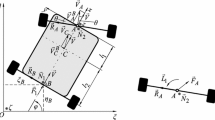Abstract
The problem of the brachistochronic motion of a holonomic scleronomic mechanical system is analyzed. The system moves in an arbitrary field of known potential forces. The problem is formulated as an optimal control task, where generalized speeds are taken as control variables. The problem considered is reduced to solving the corresponding two-point boundary-value problem (TPBVP). In order to determine the global minimal solution of the TPBVP, an appropriate numerical procedure based on the shooting method is presented. The global minimal solution represents the solution with the minimum time of motion. The procedure is illustrated by an example of determining the brachistochronic motion of a disk that performs plane motion in a vertical plane in a homogeneous field of gravity.







Similar content being viewed by others
References
Djukic Dj S, Atanackovic TM (1976) A note on the classical brachistochrone. Z Angew Math Phys 27:677–681
McConnell AJ (1930) The brachistochronic motion of a dynamical system. Proc R Irish Acad 39A:31–48
Bertolazzi E, Biral F, Da Lio M (2006) Symbolic numeric efficient solution of optimal control problems for multibody systems. J Comput Appl Math 185:404–421
Stoer J, Bulirsch J (1993) Introduction to numerical analysis. Springer, New York
Dixon LCW, Biggs MC (1972) The advantages of adjoint control transformations when determining optimal trajectories by Pontryagin’s maximum principle. Areonaut J 76:169–174
Seywald H, Kumar RR (1996) Method for automatic costate calculation. J Guid Control Dyn 19:1252–1261
Fahroo F, Ross IM (2001) Costate estimation by a Legendre pseudospectral method. J Guid Control Dyn 24:270–277
Hull DG (2008) Initial Lagrange multipliers for the shooting method. J Guid Control Dyn 31:1490–1492
Graichen K, Petit N (2008) A continuation approach to state and adjoint calculation in optimal control applied to the reentry problem. In: Proceedings of the 17th World congress the international federation of automatic control Seoul, Korea, July 6–11, pp 14307–14312
Jiang F, Baoyin H, Li J (2012) Practical techniques for low-thrust trajectory optimization with homotopic approach. J Guid Control Dyn 35:245–258
Park Ch, Guibout V, Scheeres D (2006) Solving optimal continuous thrust rendezvous problems with generating functions. J Guid Control Dyn 29:321–331
Obradović A, Šalinić S, Jeremić O et al (2014) On the brachistochronic motion of a variable-mass mechanical system in general force fields. Math Mech Solids 19:398–410
Mehrpouya MA, Shamsi M (2015) Gauss pseudospectral and continuation methods for solving two-point boundary value problems in optimal control theory. Appl Math Model 39:5047–5057
Lurie AI (2002) Analytical mechanics. Springer, Berlin Heidelberg
Papastavridis JG (2002) Analytical mechanics. Oxford University Press, New York
Kelley H, Kopp RE, Moyer GH (1967) Singular extremals. In: Leitmann G (ed) Topics in optimization (mathematics in science and engineering, 31). Academic Press, New York, pp 63–101
Gabasov R, Kirillova FM (1972) High order necessary conditions for optimality. SIAM J Control 10:127–168
Bryson AE, Ho YC (1975) Applied optimal control. Hemisphere, New York
Hull D (2003) Optimal control theory for applications. Springer, New York
Hull D (1990) On the variational process in optimal control theory. J Optimiz Theory App 67:447–462
Strang G (1988) Linear algebra and its applications, 3rd edn. Harcourt Brace Jovanovich, San Diego
Ruskeepaa H (2009) Mathematica ®Navigator: mathematics, statistics, and graphics, 3rd edn. Academic Press, Burlington
Hirsch MJ, Pardalos PM, Resende MGC (2009) Solving systems of nonlinear equations with continuous GRASP. Nonlinear Anal Real 10:2000–2006
Song W, Wang Y, Li H-X et al (2015) Locating multiple optimal solutions of nonlinear equation systems based on multiobjective optimization. IEEE T Evolut Comput 19:414–431
Antunes ACB, Siguad C (2010) Controling nonholonomic Chaplygin systems. Braz J Phys 40:131–140
Čović V, Vesković M (2009) Brachistochronic motion of a multibody system with Coulomb friction. Eur J Mech A Solid 28:882–890
Šalinić S, Obradović A, Mitrović Z (2012) On the brachistochronic motion of mechanical systems with unilateral constraints. Mech Res Commun 45:1–6
Šalinić S, Obradović A, Mitrović Z et al (2013) On the brachistochronic motion of the Chaplygin sleigh. Acta Mech 224:2127–2141
Yablonskii AA, Nikiforova VM (1966) Course of theoretical mechanics, vol 1, 3rd edn. Vischaya Shkola, Moscow (in Russian)
Scheiber E, Lupu M (1997) Numerical solutions to inverse problems of general planar motion. Comput Methods Appl Mech Eng 146:197–214
Zypman FR (2007) Instantaneous center of rotation and centrodes: background and new examples. Int J Mech Eng Educ 35:79–90
Acknowledgments
This research was supported under Grants Nos. ON17400 and TR35006 by the Ministry of Education, Science and Technological Development of the Republic of Serbia. This support is gratefully acknowledged.
Author information
Authors and Affiliations
Corresponding author
Rights and permissions
About this article
Cite this article
Radulović, R., Obradović, A. & Šalinić, S. Contribution to the determination of the global minimum time for the brachistochronic motion of a holonomic mechanical system. Meccanica 52, 795–805 (2017). https://doi.org/10.1007/s11012-016-0425-z
Received:
Accepted:
Published:
Issue Date:
DOI: https://doi.org/10.1007/s11012-016-0425-z



